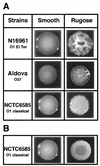High-frequency rugose exopolysaccharide production by Vibrio cholerae
- PMID: 12406780
- PMCID: PMC129946
- DOI: 10.1128/AEM.68.11.5773-5778.2002
High-frequency rugose exopolysaccharide production by Vibrio cholerae
Abstract
Vibrio cholerae can shift to a "rugose" phenotype, thereby producing copious exopolysaccharide (EPS), which promotes its environmental survival and persistence. We report conditions that promote high-frequency rugose EPS production (HFRP), whereby cells switch at high frequency (up to 80%) to rugose EPS production. HFRP appeared to be more common in clinical strains, as HFRP was found in 6 of 19 clinical strains (32%) (including classical, El Tor, and non-O1 strains) but in only 1 of 16 environmental strains (6%). Differences were found between strains in rugose colony morphology, conditions promoting HFRP, the frequency of rugose-to-smooth (R-S) cell reversion, and biofilm formation. We propose that rugose EPS and HFRP provide an evolutionary and adaptive advantage to specific epidemic V. cholerae strains for increased persistence in the environment.
Figures



References
-
- Aldova, E., K. Laznickova, E. Stepankova, and J. Lietava. 1968. Isolation of nonagglutinable vibrio from an enteritis outbreak in Czechoslovakia. J. Infect. Dis. 118:25-31. - PubMed
-
- Ali, A., J. A. Johnson, A. A. Franco, D. J. Metzger, T. D. Connell, J. G. J. Morris, and S. Sozhamannan. 2000. Mutations in the extracellular protein secretion pathway genes (eps) interfere with rugose polysaccharide production in and motility of Vibrio cholerae. Infect. Immun. 68:1967-1974. - PMC - PubMed
-
- Colwell, R. R., P. R. Brayton, D. J. Grimes, D. R. Roszak, S. A. Huq, and L. M. Palmer. 1985. Viable, but non-culturable Vibrio cholerae and related pathogens in the environment: implications for release of genetically engineered microorganisms. Bio/Technology. 3:817-820.
-
- Felix, H. 1971. The development of the cholera epidemic in West Africa. Bull. Soc. Pathol. Exot. Filiales 64:561-582. (In French.) - PubMed
Publication types
MeSH terms
Substances
Grants and funding
LinkOut - more resources
Full Text Sources
Molecular Biology Databases

